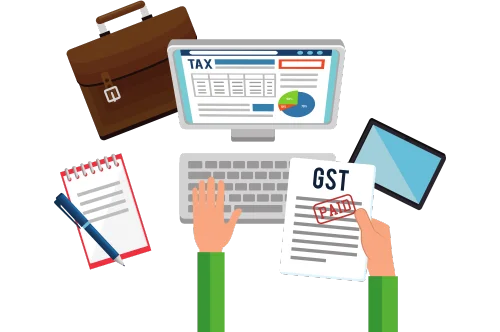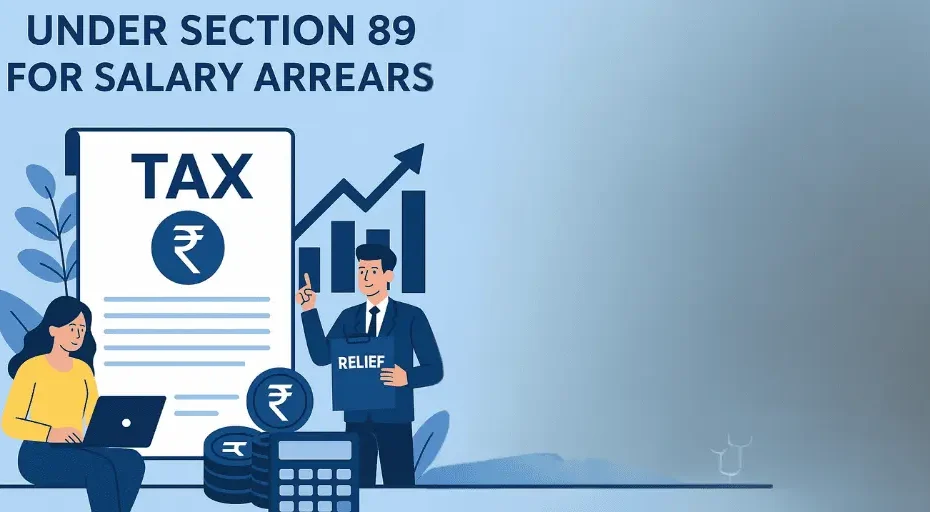How to Claim Relief Under Section 89 for Salary Arrears
When employees receive salary arrears, pensions in arrears, or advance payments, they often face a steep tax liability due to the lump-sum nature of these payments. This can unfairly push taxpayers into a higher tax bracket, inflating their tax burden. Fortunately, the Income Tax Act of India offers a solution: relief under Section 89. This provision is designed to ensure that taxpayers are not penalized simply because of the timing of their income.
In this blog, we will explore how relief under Section 89 works, who is eligible, how to calculate the relief, and the step-by-step process to claim it using Form 10E.
What Is Relief Under Section 89?
Relief under Section 89 is a provision under the Income Tax Act, 1961, that provides tax relief to individuals who receive any portion of their salary or family pension in arrears or in advance. Without this relief, the entire amount received in one financial year would be taxed in that year, potentially pushing the taxpayer into a higher tax slab.
To avoid this unfair burden, relief under Section 89 allows taxpayers to spread out the income over the years to which it actually pertains, resulting in a fairer tax calculation.
When Can You Claim Relief Under Section 89?
You can claim relief under Section 89 in the following situations:
Salary received in arrears or advance
Family pension received in arrears
Gratuity received for past services
Commuted pension
Compensation on termination of employment
Premature withdrawal from Provident Fund
Each of these payments can lead to a higher tax burden in the year of receipt, which is exactly what relief under Section 89 is meant to alleviate.
Eligibility Criteria for Claiming Relief
To avail relief under Section 89, the following conditions must be met:
You must be a salaried individual or pensioner.
You must have received income in arrears or advance.
The arrears/advance should relate to one or more previous financial years.
You must file Form 10E before filing your income tax return.
Remember: Form 10E filing is mandatory. If not submitted, the Income Tax Department may deny your relief under Section 89 claim.
Calculation of Relief Under Section 89
The calculation process for relief under Section 89 involves a comparative method. Here’s a simplified version of how it works:
Step 1: Compute tax payable on total income including arrears (in the current year).
Step 2: Compute tax payable on total income excluding arrears (in the current year).
Step 3: Calculate the difference between Step 1 and Step 2. This gives the additional tax due to arrears.
Step 4: Compute the tax payable on the total income of each year to which the arrears relate including the portion of arrears.
Step 5: Compute the tax payable on the total income of each year to which the arrears relate excluding the portion of arrears.
Step 6: Calculate the difference between Step 4 and Step 5. This gives the additional tax that would have been payable in those years.
Step 7: The relief under Section 89 is the difference between the tax calculated in Step 3 and the tax calculated in Step 6.
If the tax burden in the current year is higher than what it would have been if spread across previous years, relief under Section 89 is granted for the excess.
How to Claim Relief Under Section 89 Using Form 10E
Filing Form 10E is essential to claim relief under Section 89. Here is a step-by-step guide:
Step 1: Log in to the Income Tax e-Filing Portal
Visit https://www.incometax.gov.in and log in using your PAN, password, and captcha.
Step 2: Go to the e-File Section
Navigate to e-File > Income Tax Forms > File Income Tax Forms.
Step 3: Select Form 10E
From the list of available forms, select Form 10E – Relief under Section 89(1) and click on “Continue.”
Step 4: Fill in Required Details
You’ll be asked to provide:
Assessment year
Type of income received (arrears, gratuity, compensation, etc.)
Year-wise breakup of arrears
Total income in each relevant year
Step 5: Preview and Submit
Review your entries carefully. Once verified, submit the form digitally.
Step 6: File ITR
After submitting Form 10E, proceed to file your Income Tax Return (ITR). Ensure that the relief is reflected under the section “Tax Relief” in your ITR.
Important Note: If you don’t file Form 10E, the CPC (Centralized Processing Center) may reject your relief claim, even if your ITR reflects the correct computation.
Example to Illustrate Relief Under Section 89
Suppose you received ₹1,00,000 as salary arrears in FY 2024–25, which pertained to FY 2022–23. Here’s how relief under Section 89 helps:
Without relief, the entire ₹1,00,000 would be taxed in FY 2024–25, possibly pushing you into a higher tax slab.
With relief, tax will be calculated as if ₹1,00,000 was received in FY 2022–23, and you’ll pay only the additional tax applicable at that time.
The difference in tax burden is the relief under Section 89.
This way, you’re not penalized simply because your employer paid you late.
Documents Needed to Claim Relief
Before filing relief under Section 89, keep the following ready:
Detailed breakup of arrears received
Salary slips or certificates from employer
Form 16 from the year of receipt and years the arrears pertain to
Computation sheet for tax calculations
PAN, Aadhaar, and login credentials for the e-filing portal
Common Mistakes to Avoid
Not filing Form 10E – This is the most frequent reason for denial of relief.
Incorrect year-wise breakup – Ensure that arrears are properly split across relevant financial years.
Mismatch with Form 16 – The data you enter should match with the Form 16 issued by your employer.
Assuming automatic relief – You must claim it actively; the Income Tax Department does not apply relief under Section 89 automatically.
Final Thoughts
Claiming relief under Section 89 is crucial if you’ve received salary arrears or any lump-sum payment related to prior financial years. Without this relief, you could end up paying more tax than necessary. The process is relatively straightforward but requires attention to detail, especially in accurately filing Form 10E and matching data with previous years’ records.
Our GST Services

All E-commerce Tax services
E-commerce tax services help online sellers navigate GST registration, compliance, return filing, TCS management, tax planning, and audits, ensuring efficient tax management and legal compliance.

GST Filing
GST filing is the process of submitting tax returns to the government, detailing sales, purchases, and taxes paid or collected, ensuring compliance with GST laws.

GST Registration
GST registration is the process where businesses obtain a GSTIN from the government, allowing them to collect taxes, claim input tax credits, and comply with GST laws.






It is appropriate time to make a few plans for the long run and it is time to be happy.
I have learn this publish and if I could I desire to counsel you some
interesting issues or tips. Maybe you could write subsequent articles regarding this article.
I desire to learn more things approximately it!
It’s amazing to pay a quick visit this web page and reading the views of all colleagues concerning this article, while I am also keen of getting familiarity.
What’s Going down i’m new to this, I stumbled upon this I have discovered It absolutely useful and it has aided me out loads. I am hoping to give a contribution & assist other users like its helped me. Great job.
Great post. I was checking constantly this blog and I am impressed! Extremely useful information specifically the last part 🙂 I care for such information a lot. I was seeking this certain info for a long time. Thank you and good luck.
I have been surfing online greater than three hours today, but I by no means found any attention-grabbing article like yours. It is pretty price enough for me. In my view, if all website owners and bloggers made excellent content material as you did, the web can be much more helpful than ever before.
Thanks , I’ve just been looking for information approximately this topic for a while and yours is the greatest I’ve found out so far. But, what about the conclusion? Are you certain about the supply?
Appreciation to my father who informed me on the topic of this web site, this website is really amazing.
I just like the valuable information you provide on your articles.I’ll bookmark your blog and test again here frequently.I’m quite certain I’ll be informed plenty of new stuff proper right here! Good luck for the next!
It’s enormous that you are getting ideas from this paragraph as well as from our dialogue made at this time.
Everyday consumption of weight reduction capsules can offer a number of physical benefits, consisting of enhanced cravings guideline and improved metabolic activity. These effects might add to a lot more efficient fat oxidation and continual energy throughout the day. In addition, some formulas support immune health and wellness and supply antioxidant benefits, which can be valuable during weight decrease efforts,
Hi to every body, it’s my first pay a visit of this weblog; this weblog contains remarkable and genuinely excellent material designed for readers.
Hi there to every one, since I am really eager of reading this blog’s post to be updated on a regular basis. It includes fastidious data.
When someone writes an piece of writing he/she keeps the thought of a user in his/her brain that how a user can know it. So that’s why this paragraph is outstdanding.
You’re so interesting! I don’t suppose I have read something like this before. So nice to discover another person with a few genuine thoughts on this subject. Seriously.. many thanks for starting this up. This web site is something that’s needed on the web, someone with a little originality!